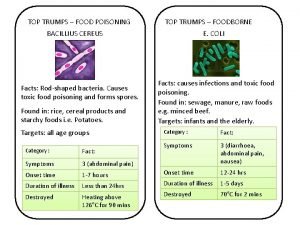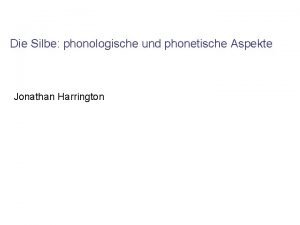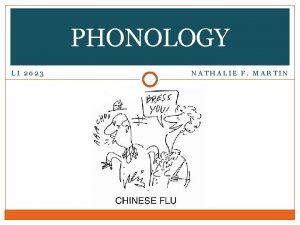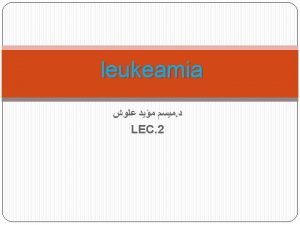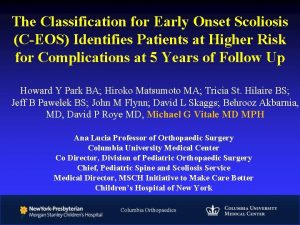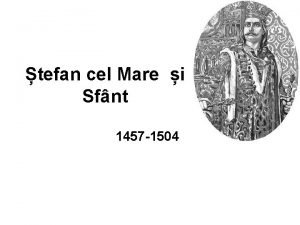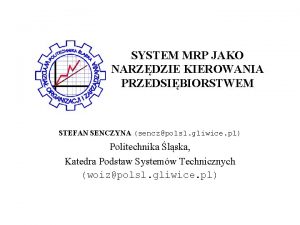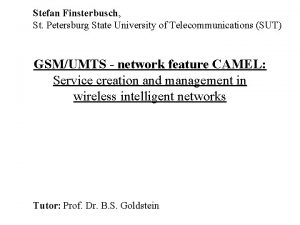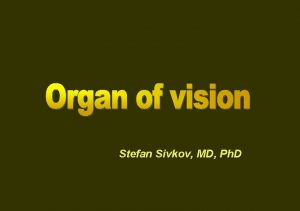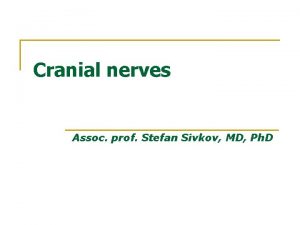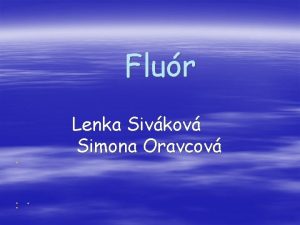Stefan Sivkov MD Ph D Development Onset 22







































- Slides: 39

Stefan Sivkov, MD, Ph. D

Development А. Onset 22 day of gestation; from neuroectoderm, ectoderm & mesoderm. B. Diencephalic vesicle gives origin to optic vesicle; after invagination develops double-layered optic cup. i) Inner layer develops into в pars nervosa of retina ii) Outer layer gives pars pigmentosa of retina, pigmentous epithelium of iris and ciliary body. C. Ectoderm gives origin of : i) Lens. ii) Corneal epithelium and conjunctiva. D. Mesoderm gives origin of: i) Stroma of sclera and cornea. ii) Stroma of choroid.

Development

Three parts n Optic apparatus – controls the light entering the eye n Detector system – for black / white and color vision n Nerve pathways – conveys signals to brain

Eye ball 3 coats Tunica Fibrosa: cornea, sclera Tunica Vasculosa: choroidea, corpus ciliare, iris Tunica Nervosa: retina 3 chambers Anterior eye chamber Posterior eye chamber Corpus vitreum

Tunicae bulbi Outer, tunica fibrosa bulbi - cornea (transparent) - sclera (non-transparent, bluish in children, yellowish in adults) Middle, tunica vasculosa bulbi - iris and central opening, рupilla - corpus ciliare composed of: musculus ciliaris, processus ciliaris, zonula ciliaris with fibrae zonulares & spatia zonularia - choroidеа Inner, tunica interna bulbi (retina) - blind part, рars caeca retinae (from мargo pupillaris iridis to оra serrata): Pars iridica retinae (double-layered, pigmented cells) Pars ciliaris retinae (double-layered, pigmented inner layer) - рars optica retinae (stratified)

Eye chambers Three chambers filled with fluid: n Camera anterior bulbi (between cornea & iris), n Camera рosterior bulbi (between iris, fibrae zonulare & lens) n Corpus vitreum (between lens & retina). The nfirst two filled with humor aquosus, Corpus vitreum filled with humor vitreus.


Tunica fibrosa

Sclera Posterior 4/5 of tunica fibrosa; Collagen & elastic fibers, fibroblasts (substantia propria sclerae), 3 layers: § episclera: outer § substantia propria sclerae: middle § lamina fusca: inner, collagen & elastic fibers pigment cells; borders choroid

Cornea А. Anterior 1/5 of the coat Б. 5 – layered: - Epithelium anterius: squamous stratified nonceratizing, 5 - 6 layers: - Lamina limitans anterior (Bowman): 7 -12 mcm, collagen fibers, lacks cells, barrier agains infection, does not regenerates. - Substantia prоpria: 200 laminae of parallel collagen fibers. - Lamina limitans posterior (Descemet): 5 - 10 mcm, basal lamina of endothelium. - Endothelium posterius: simple squamous epithelium

i) Avascular ii) Transparent iii) Limbus - connection with sclera: Highly vascular Contains sinus venosus sclerae (Schlemm canal)

Tunica vasculosa Three parts: 1. Posterior - сhoroidea 2. Middle - сorpus ciliare 3. Anterior - iris

Choroidea n n 2/3 of the coat Attached posteriorly to the sclera – Spatium perichoroidale – Lamina suprachoroidea n Composed of: – – – n Connective tissue Pigment cells Blood vessels 3 layers: – Lamina vasculosa – Lamina choriocapillaris – Lamina basalis (Bruch)

Choroidea

Corpus ciliare n n Orbiculus ciliaris – posterior Corona ciliaris - anteromedial – Processus ciliares (70 -80) n n Dense capillary network Produce humor aquosus Fibrae zonulares Musculus ciliaris - lateral n n n Fibrae meridionales (Brucke) Fibrae radiales Fibrae circulares (Muller) – Takes part in (n. oculomotorius)

Coprpus ciliare Orbiculus ciliaris, corona ciliaris

Accomodation n Focusing for near vision n Contraction of the pupil n Convergence

Accomodation n M. ciliaris contracts and moves forward n That relaxes zonule ciliares and lens becomes more convex n The eye adapts to near vision

Iris n Color is genetically determined. n Pigment: а. melanin & b. lipochrome. n Melanin - gene of 15 chromosome. n Lypochrome - gene of 19 chromosome.

Iris n n n Anterior part Opening in the middle, pupilla. Margo pupillaris & margo ciliaris Annulus iridis minor & anulus iridis major Structure – Epithelium anterius – Stroma iridis – M. sphincter & dilatator pupillae – Epithelium pigmentosum Attached to the sclera by lig. pectinatum


Iris. Ligamentum pectinatum


Retina n n Eye fundus discus nervi optici (2 x 1. 5 mm), central - excavation. 4 mm lateral is an oval spot, fovea, in the center of macula lutea. Centarl part of retina – d=21 mm from the center of discus n. optici. Diameter of retina - 42 mm.

Structure n Retina (0. 5 mm) inner layer. n N. opticus – axons of the ganlion cells. n Ganglion cells, efferent, the innermost. n Photoreceptive cells, rod and cones, outer.

RETINA 1. Pars pigmentosa - detachment of retina 2. Pars nervosa (1) Stratum neuroepitheliale Bacillus, Conus (2) Stratum nucleare externum Bipolar cell Horizontal cell Amacrine cell (3) Stratum nucleare internum Ganglion cell Nervus Opticus (II)

Structure of retina n Three cellular layers Outer nuclear – bodies of rods & cones Inner nuclear – bodies of bipolar, horizontal & amacrine cells Ganglion – bodiesa of ganglion cells. n Two synaptic layers Outer plexiform Inner plexiform

Synaptic layers Stratum plexiforme externum Stratum plexiforme internum

Ora serrata. Pars optica & pars ceca retinae

Fovea centralis

Rods and cones


Optic nerve

Visual Pathway

Visual Pathway Modality: Vision Receptor: Photoreceptor Cell of Retina Cranial Nerve: II (Optic nerve) 1 st Neuron: Bipolar Cell 2 nd Neuron: Ganglion Cell optic nerve optic chiasm optic tract 3 rd Neuron: Lateral Geniculate Nucleus optic radiation Termination: Primary Visual Area (V I) Brodmann area 17

Visual Pathway 1. Optic nerve 2. optic chiasm 3. optic tract 4. lateral geniculate body 5. optic radiation 6. visual cortex (striate cortex) 7. Meyer’s loop 8. lateral ventricle

Visual Pathway 1. Optic nerve 2. Optic chiasm 3. Optic tract 4. Lateral geniculate body 5. Optic radiation 6. Visual cortex (Striate cortex)

Clinical Features of Visual Pathway Lesion 1. optic nerve 2. optic chiasm 3. optic tract 4. 5. optic radiation A. unilateral blindness B. bitemporal hemianopsia C. left homonymous hemianopsia D. left inferior homonymous quadranopsia E. left superior homonymous quadranopsia
 Silbengewicht
Silbengewicht Maximum onset principle
Maximum onset principle Top trumps food
Top trumps food Voice onset time
Voice onset time Silbenanlaut
Silbenanlaut Assimilation of voice examples
Assimilation of voice examples Allophones examples
Allophones examples Probability marginalization
Probability marginalization Insulin peak and duration
Insulin peak and duration Gastroenterritis
Gastroenterritis Anaphylaxis onset
Anaphylaxis onset Lenisierung beispiel
Lenisierung beispiel Nph onset and peak
Nph onset and peak Onset coda and nucleus
Onset coda and nucleus Normal laber
Normal laber Maximal onset principle
Maximal onset principle Abrupt stormy onset
Abrupt stormy onset Onset and coda examples
Onset and coda examples Maximal onset principle example
Maximal onset principle example Early onset scoliosis classification
Early onset scoliosis classification The sound patterns of language
The sound patterns of language Types of insulin chart
Types of insulin chart Onset offset trial
Onset offset trial Stefan brands
Stefan brands Imn lui stefan cel mare
Imn lui stefan cel mare Stefan senczyna
Stefan senczyna Katarina blomberg
Katarina blomberg Stefan wyszyński krótki życiorys
Stefan wyszyński krótki życiorys Stefan lunkenheimer
Stefan lunkenheimer Stefan finsterbusch
Stefan finsterbusch Bahn signallampe 1939
Bahn signallampe 1939 Stefan
Stefan Stefan kinne
Stefan kinne Stefan bathe
Stefan bathe Stefan siedlecki
Stefan siedlecki Stefan wyszyński ciekawostki
Stefan wyszyński ciekawostki Unibw rechenzentrum
Unibw rechenzentrum Google intrapreneurship program
Google intrapreneurship program Stefan hinrichs
Stefan hinrichs Stefan tache
Stefan tache


